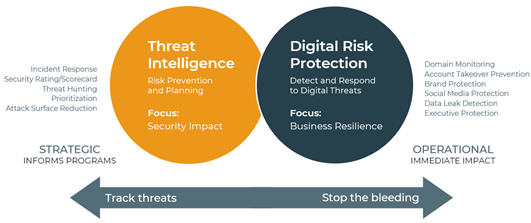Digital risk protection (DRP) is rapidly gaining traction among CISOs and security professionals. Once considered a subset of digital threat intelligence (DTI), DRP has emerged as a distinct security function, highlighted by Gartner Hype Cycle and other analyst research for its ability to address a wide range of external cyber threats. Many enterprises rely on DRP daily to safeguard digital assets, but for those new to the concept, it’s worth understanding how DRP differs from threat intelligence and why it’s increasingly critical for protecting organizations from external attacks.
Recent research emphasizes the growing importance of cyber-risk management for executives and regulators alike. DRP solutions are expanding quickly, fueled by a broad spectrum of threat detection and response capabilities. Their ability to accelerate both the depth and breadth of external threat protection drives rising demand. Yet, despite its growth, some confusion remains around the overlap between DRP and digital threat intelligence, and how organizations should prioritize each.
Why Digital Risk Protection?


Digital Risk Protection vs. Digital Threat Intelligence: Understanding the Difference
While DRP helps enterprises detect and stop active external threats in real time, digital threat intelligence takes a longer-term, strategic approach. It systematically gathers and analyzes large datasets to predict potential threats, inform decision-making, and protect internal resources before attacks occur.
DTI uses investigative processes to assess the potential security impact and severity of emerging threats. Its goal is to map the full risk landscape of an organization, anticipate vulnerabilities, and allocate resources for optimal protection. Common applications include incident response planning, developing security ratings and scorecards, prioritizing threats strategically, and assessing an organization’s attack surface to reduce exposure.
Although thorough and resource-intensive, threat intelligence gives organizations the foresight and capabilities to identify and mitigate risks as they emerge. It’s not a standalone solution. Maximizing DTI's value requires complementary security investments and mature programs to fully defend against threats.
So, Which Comes First?
As cyber threats continue to expand, stretching security budgets and resources, it’s understandable that teams struggle to decide where to focus. Ideally, digital risk protection and threat intelligence work together as complementary components of a comprehensive security program. But organizations should first evaluate their strategic and operational needs—considering the volume, severity, and risk of the threats they face daily—to determine where to invest.
Traditional threat intelligence maps long-term strategic threats but isn’t optimized for rapidly mitigating active external attacks. DRP, on the other hand, is flexible, adaptable, and immediately actionable, giving security teams the operational capability to identify and stop threats in real time.
Another advantage of DRP is that it doesn’t depend on program maturity or company size. It allows organizations to implement protection incrementally, layering functions over time as their security strategy matures. This flexibility reduces the cost of entry and ensures that businesses can quickly gain value from DRP while defending against their unique external threats.
